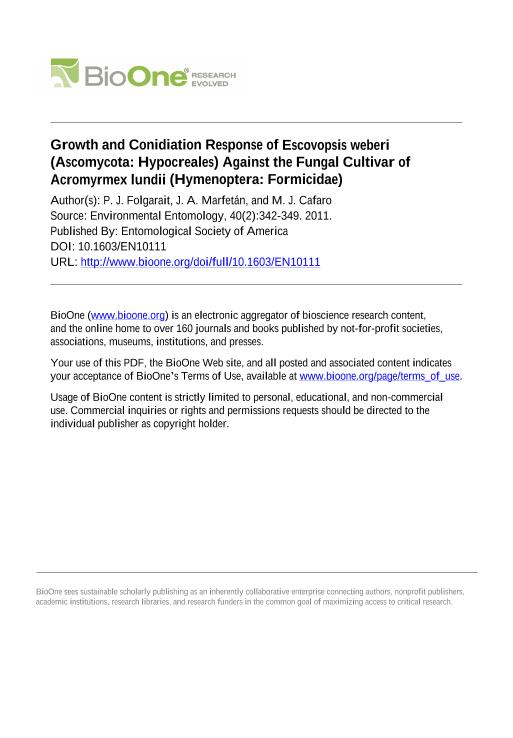Mostrar el registro sencillo del ítem
dc.contributor.author
Folgarait, Patricia Julia

dc.contributor.author
Marfetan, Jorge Ariel

dc.contributor.author
Cafaro, M. J.
dc.date.available
2023-03-31T14:53:02Z
dc.date.issued
2011-04
dc.identifier.citation
Folgarait, Patricia Julia; Marfetan, Jorge Ariel; Cafaro, M. J.; Growth and conidiation response of escovopsis weberi (Ascomycota: Hypocreales) against the fungal cultivar of acromyrmex lundii (Hymenoptera: Formicidae); Entomological Society of America; Environmental Entomology; 40; 2; 4-2011; 342-349
dc.identifier.issn
0046-225X
dc.identifier.uri
http://hdl.handle.net/11336/192308
dc.description.abstract
Leaf-cutter ants (Acromyrmex and Atta spp.) exhibit ancient and complex interactionswith the symbiotic fungus Leucoagaricus (Basidiomycetes: Agaricales) from which they feed, and withthe virulent and speciÞc fungus Escovopsis weberi J.J. Muchovej & Della Lucia (Ascomycetes:Hypocreales) that attacks the antsÕ fungal gardens. This system offers a unique opportunity to studypossible avenues for replacing polluting pesticides with a biological control agent against the ants. Weisolated both Leucoagaricus sp. and E. weberi from the gardens of Acromyrmex lundii Gue´ rin-Me´ nevillecolonies and confronted them with each other by growing Leucoagaricus on petri dishes and placinginoculated pieces of agar inoculated with E. weberi at the edges. Here we present growth curves ofLeucoagaricus sp. and E. weberi in the absence of each other, as a baseline to which we compare theeffect of the fungi on each other. As expected, we found a negative effect of E. weberi on the ant cultivarfrom different colonies of A. lundii. E. weberi increased its growth rate, as well as the levels ofconidiation, in the presence of the ant cultivar. We determined that a soluble and diffusible compound,released by the cultivar, triggered, was responsible for, or did both for the increased levels ofconidiation in E. weberi, and that this response was reversible. We discuss why our results areencouraging from a biological control perspective.
dc.format
application/pdf
dc.language.iso
eng
dc.publisher
Entomological Society of America

dc.rights
info:eu-repo/semantics/openAccess
dc.rights.uri
https://creativecommons.org/licenses/by-nc-sa/2.5/ar/
dc.subject
ANT PESTS
dc.subject
BIOLOGICAL CONTROL
dc.subject
FUNGI-FUNGI INTERACTIONS
dc.subject
INDUCTION OF CONIDIATION
dc.subject
LEAFCUTTER ANTS
dc.subject.classification
Micología

dc.subject.classification
Ciencias Biológicas

dc.subject.classification
CIENCIAS NATURALES Y EXACTAS

dc.title
Growth and conidiation response of escovopsis weberi (Ascomycota: Hypocreales) against the fungal cultivar of acromyrmex lundii (Hymenoptera: Formicidae)
dc.type
info:eu-repo/semantics/article
dc.type
info:ar-repo/semantics/artículo
dc.type
info:eu-repo/semantics/publishedVersion
dc.date.updated
2023-03-30T14:42:53Z
dc.journal.volume
40
dc.journal.number
2
dc.journal.pagination
342-349
dc.journal.pais
Estados Unidos

dc.description.fil
Fil: Folgarait, Patricia Julia. Consejo Nacional de Investigaciones Científicas y Técnicas; Argentina. Universidad Nacional de Quilmes. Departamento de Ciencia y Tecnología. Laboratorio de Hormigas; Argentina
dc.description.fil
Fil: Marfetan, Jorge Ariel. Universidad Nacional de Quilmes. Departamento de Ciencia y Tecnología. Laboratorio de Hormigas; Argentina. Consejo Nacional de Investigaciones Científicas y Técnicas; Argentina
dc.description.fil
Fil: Cafaro, M. J.. Universidad de Puerto Rico; Puerto Rico
dc.journal.title
Environmental Entomology

dc.relation.alternativeid
info:eu-repo/semantics/altIdentifier/doi/http://dx.doi.org/10.1603/EN10111
Archivos asociados
